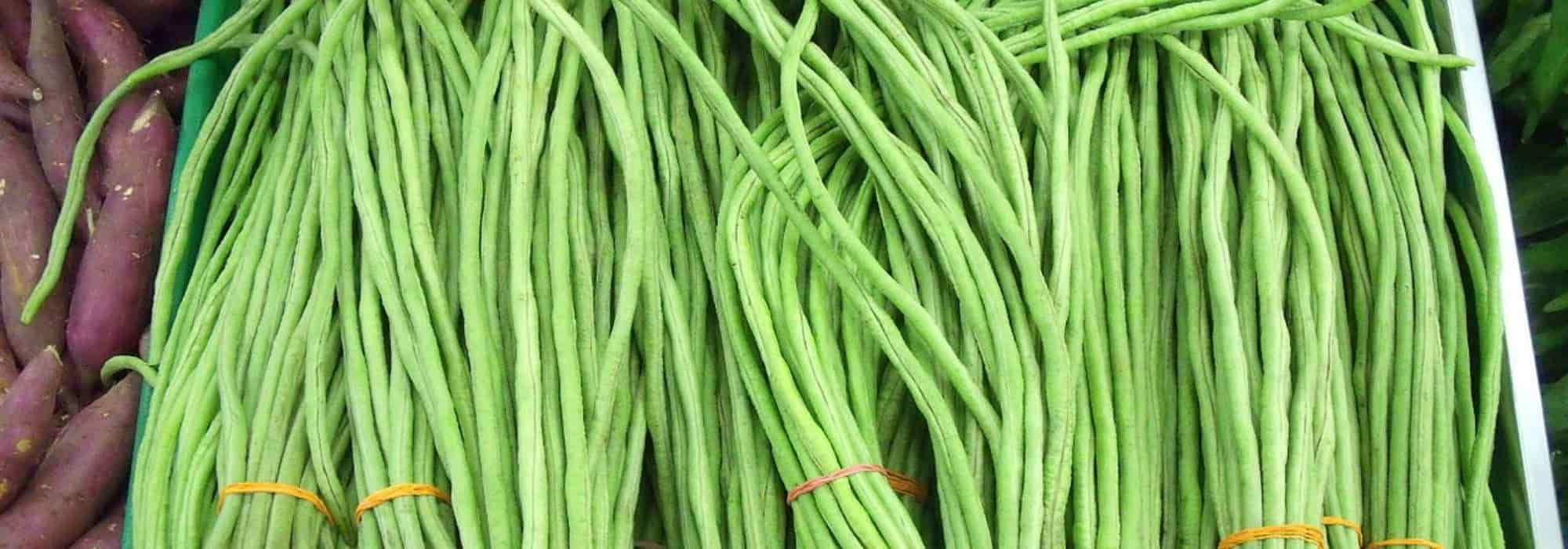
Runner bean: sowing, growing and harvesting
Contents
The runner bean in a nutshell
- Also known as yardlong bean, the kilometre bean (Vigna unguiculata subsp. sesquipedalis) belongs to the Fabaceae family.
- This herbaceous plant grown as a vegetable produces long, slender pods that can reach up to a metre, with a flavour reminiscent of both beans and asparagus.
- Native to tropical and subtropical regions, the kilometre bean requires warmth. It is cultivated in the south of France or under tunnels.
- It is a climbing bean with voluble stems that can extend up to 3 to 4 metres.
- Its cultivation is very simple and requires no special care.
A word from our expert
At first glance, Vigna unguiculata subsp. sesquipedalis resembles a bean. The name itself, as this vegetable plant is known as the kilometre bean or asparagus bean. Additionally, the shape of the pods inevitably evokes beans, but these are beans of a surprising size, as it is not uncommon for them to reach a metre. The foliage and flowering also resemble those of beans. Finally, Vigna unguiculata subsp. sesquipedalis, like beans, belongs to the Fabaceae family.
However, one botanical characteristic distinguishes them: the beans that we all know and grow in our gardens, whether they are string beans, climbing beans, snap beans, or shell beans, belong to the Phaseolus genus, while the remarkable kilometre bean falls under the Vigna genus. In the garden, as elsewhere, appearances can be deceiving: the kilometre bean is not a bean in the strictest sense, at least botanically speaking!
As for its flavour, it is similar to that of a bean, with a hint of asparagus.
In the vegetable garden, the kilometre bean, widely grown in tropical and subtropical regions of Asia, Africa, and South America, requires sun and warmth. It can therefore be grown in the south of France without difficulty. Elsewhere, cultivation under cover or in a tunnel is recommended to achieve beautiful pods.
Description and botany
Botanical data
- Latin name Vigna unguiculata subsp. sesquipedalis
- Family Fabaceae
- Common name Yardlong bean, asparagus bean, yardlong pea, long pod dolichos, asparagus dolichos, snake bean, Chinese long bean
- Flowering summer
- Height up to 4 metres
- Exposure full sun
- Soil type ordinary, well-drained
- Hardiness Not hardy
The yardlong bean belongs to the genus Vigna, which includes species native to the tropical and subtropical regions of the Old World, namely Asia and Africa. Some of these herbaceous species have been domesticated as vegetables, such as Vigna unguiculata subsp. sesquipedalis, our yardlong bean. The genus Vigna also includes mung bean (Vigna radiata) and cowpea (Vigna unguiculata), which are widely consumed in Africa. These two beans are primarily grown as dry legumes.
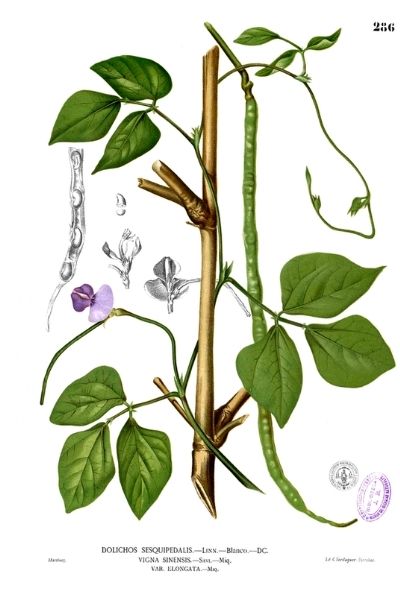
Botanical illustration
But let’s focus on this remarkable yardlong bean, commonly known as yardlong pea, asparagus bean, or long pod dolichos. These vernacular names contribute to the confusion surrounding this yardlong bean, which is not actually a bean (Phaseolus). Little known in our regions, the yardlong bean is widely consumed in Southeast Asia. In fact, it predates the bean that came from the Americas. Likely domesticated in Abyssinia 5,000 to 6,000 years ago, this yardlong bean spread to India and China, and later to Europe during the Middle Ages. Until the day the bean, arriving from the Americas in the holds of ships, dethroned it. As for the “beans” of the Vigna species, they too crossed the seas with slaves, quickly acclimatising first in the Caribbean, then in South America.
Today, the yardlong bean is one of the main vegetables grown in Southeast Asia, particularly in Taiwan, Bangladesh, and the Philippines, where it is known as “poor man’s meat”. This is simply because it is a vegetable from the Fabaceae family (formerly legumes), rich in plant proteins.
Botanically speaking, Vigna is an herbaceous plant, cultivated as a vegetable, with a climbing habit. This plant is described as sinistrorse, meaning its inermous twining stems coil from right to left, counterclockwise. These stems can reach up to 4 metres long, entwined around their supports.
The triangular leaves, arranged along the stems, are trifoliolate and have a pointed tip, measuring up to 12 cm.
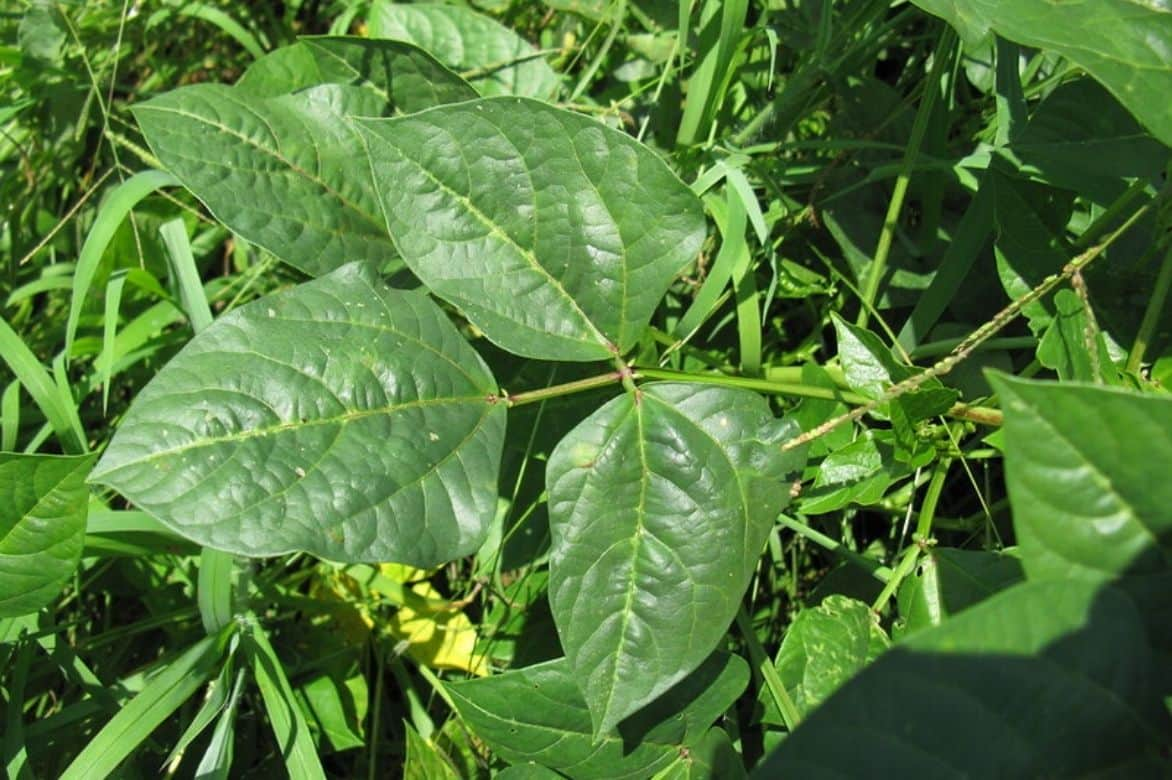
Trifoliolate leaf of the yardlong bean
From July to September, the foliage is adorned with papilionaceous flowers, grouped in pairs or solitary, which bloom at the tips of the stems on a long peduncle. These flowers display a beautiful yellow colour with purplish hues.
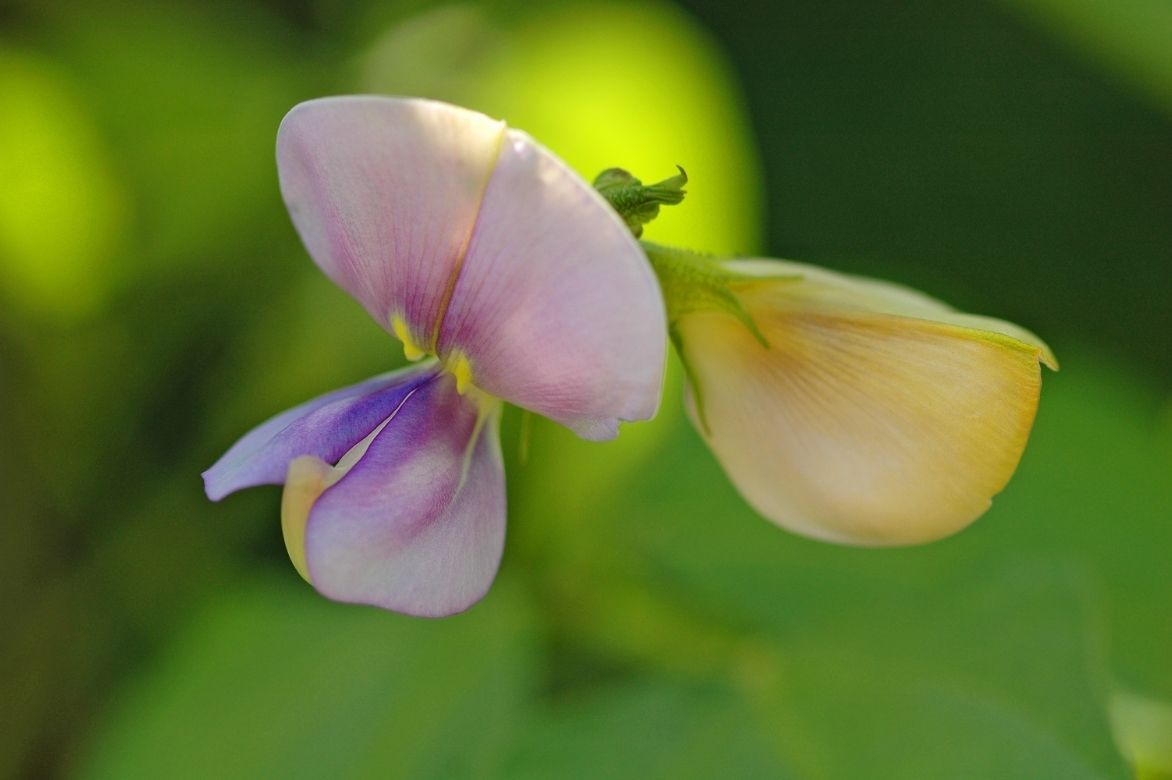
The flowers give rise to fine, long pods. Again, the yardlong bean truly deserves its name due to the size of its edible pods, which can measure up to a metre depending on the variety. Cylindrical and stringless, green or red, these pods grow in clusters. They contain seeds, most often white and kidney-shaped, which have little culinary value compared to the seeds of its cousins, cowpea and mung bean.
Native to and widely cultivated in tropical and subtropical regions, the yardlong bean is particularly sensitive to cold but withstands drought very well. Its seeds require a minimum of 20 °C to germinate.
Like all plants in the Fabaceae family, Vigna unguiculata subsp. sesquipedalis is a soil-improving plant. The yardlong bean has roots covered with nodosities that host aerobic soil bacteria, Rhizobium, with which it maintains a true symbiosis. These bacteria have the ability to fix atmospheric nitrogen and make it available to the plant. The soil is thus naturally enriched with nitrogen, a very interesting characteristic for crop rotation or intercropping.
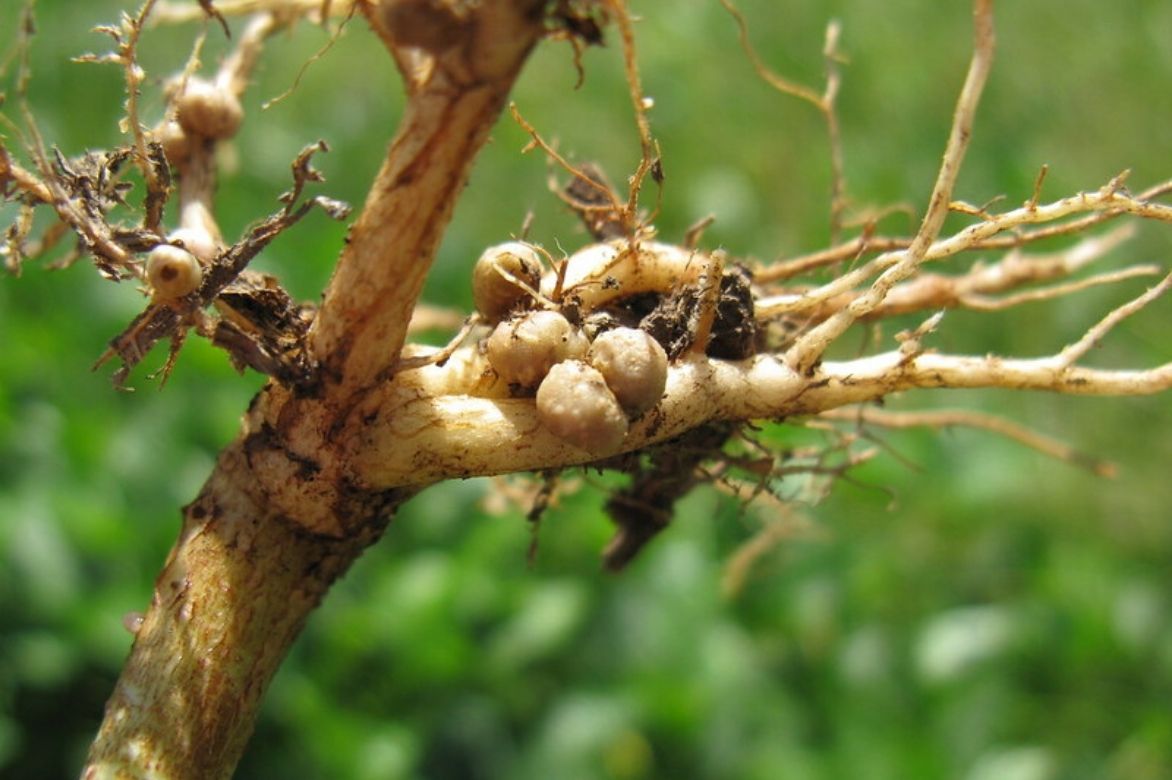
The presence of nodosities on its roots makes the yardlong bean a soil-improving plant
The different varieties of runner beans
Vigna unguiculata subsp. sesquipedalis includes several varieties derived from the typical species with long pendulous pods. The ‘Tapir’ variety, highly productive, has dark green, almost glossy pods. Some varieties produce colourful purple pods measuring 50 cm in length, such as ‘Red Noddle’. The ‘Mosaic’ variety, with a high yield, offers variegated pink and white pods that are very crunchy with a sweet flavour.
Our favourite varieties
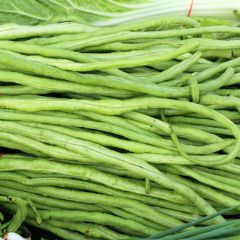
Vigna unguiculata subsp. sesquipedalis
- Flowering time June to August
- Height at maturity 4 m
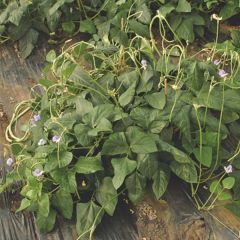
Dwarf Kilometre Bean (Kouseband) - Metro nano
- Flowering time June to September
- Height at maturity 40 cm
Discover other Yardlong Beans
View all →Available in 1 sizes
Available in 1 sizes
Available in 1 sizes
Available in 1 sizes
Available in 1 sizes
Planting the runner bean
Where to plant?
When it comes to soil, the mile-a-minute bean is not particularly demanding. An ordinary, loosened, and well-drained soil is quite sufficient for it. However, it does not appreciate calcareous soils. It is possible to add compost, but this should be done in the autumn prior to sowing. Prepare the soil well before sowing, as the mile-a-minute bean does not like compacted soils.
Its requirements are more related to temperature and thus to its exposure. As a tropical and subtropical plant, the mile-a-minute bean needs warmth. This is essential during a long summer period. The seeds should therefore be planted in full sun and sheltered from winds.
In the south of France, the asparagus bean will be sown directly in the ground. Elsewhere, direct sowing is more uncertain, so it is preferable to opt for cultivation under cover or in a tunnel.
To sow the seeds, the soil must have reached a temperature of at least 20 °C.
Like all legumes, mile-a-minute beans do not appreciate the proximity of alliums. Therefore, do not plant them next to garlic, onions, or shallots.
When to plant?
For direct sowing, it is necessary to wait until May. Once the Ice Saints have passed, all risks of late frosts are eliminated. Sowing can continue until mid-June.
Under cover, sowing takes place in April. The young plants will be transplanted in mid-May.
How to plant?
In the ground, sowing is done in clusters of 2 to 3 seeds, spaced at least 50 cm apart. The seeds are buried to a depth of 6 cm. Each row is 70 cm apart.
If you want to sow in rows, place one seed every 30 cm at a depth of 3 cm.
Under cover, the mile-a-minute bean is sown in pots or on trays. Count one seed per alveolate buried 3 cm deep. Four weeks after sowing, the seedlings are transplanted into the ground in full sun or under a tunnel if you are not assured of a long warm period.
Care for runner beans
Once sown, the kilometre bean requires very little care. Highly drought-resistant, it does not need watering. However, like green beans, hilling can be done when the plants reach 25 to 30 cm. Weeding and hoeing are never unnecessary.
Due to the vigour of their voluble stems, which can reach 3 to 4 metres, good support is essential for kilometre beans. You can use sturdy wire mesh, strong strings stretched between stakes, or plant poles in a Canadian tent or tipi formation. Your children should be quick to get involved!
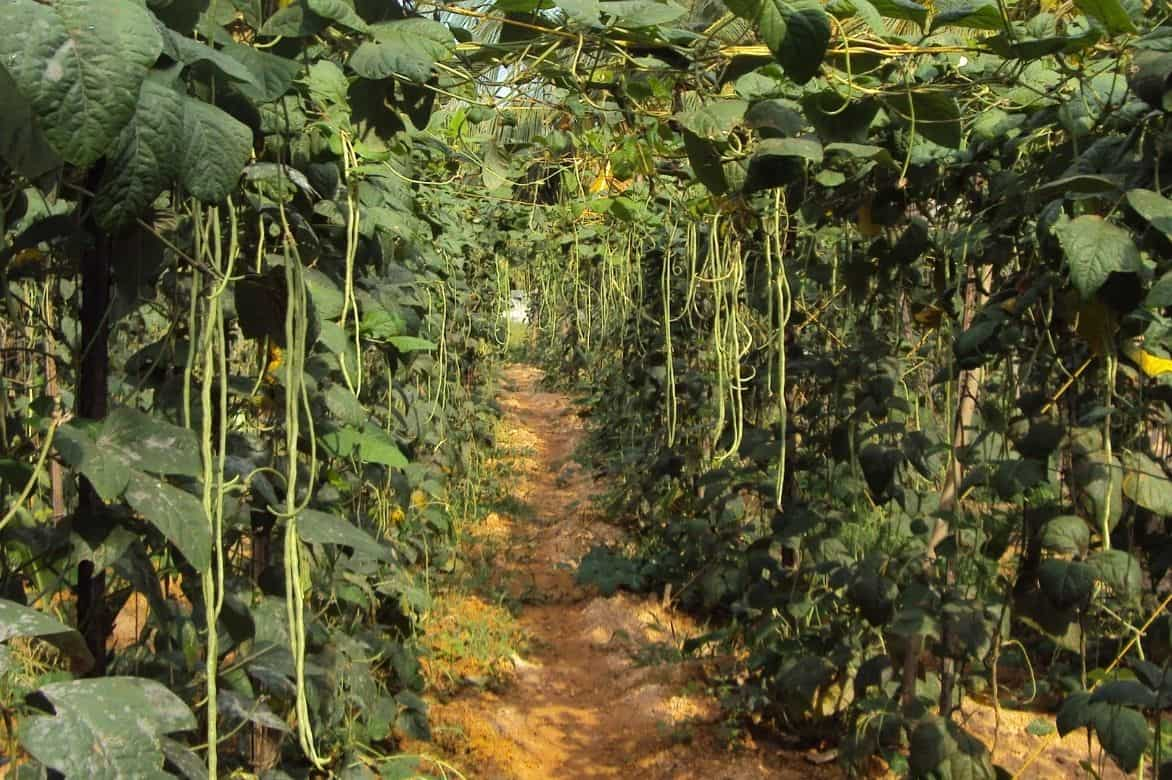
With favourable growing conditions, kilometre bean plants can reach 3 to 4 metres high and the pods can be 1 metre long.
In Africa, where the kilometre bean is cultivated, gardeners often support it on maize.
The kilometre bean is not very susceptible to diseases and pests. If grown in a greenhouse or under a tunnel, there is always a risk of red spider mite (which are actually arachnids) due to the confined atmosphere. Often, simply watering the foliage with fresh water and ventilating the space is sufficient.
Harvesting and storing runner beans
About two to three months after sowing, the kilometre beans are ready to be harvested. The harvest typically takes place from July to September-October, provided the weather conditions are suitable.
Depending on the varieties of kilometre beans, the pods are picked when they measure 30 to 40 cm. Beyond this size, they lose tenderness and flavour. As with string beans, harvesting occurs every 2 to 3 days.
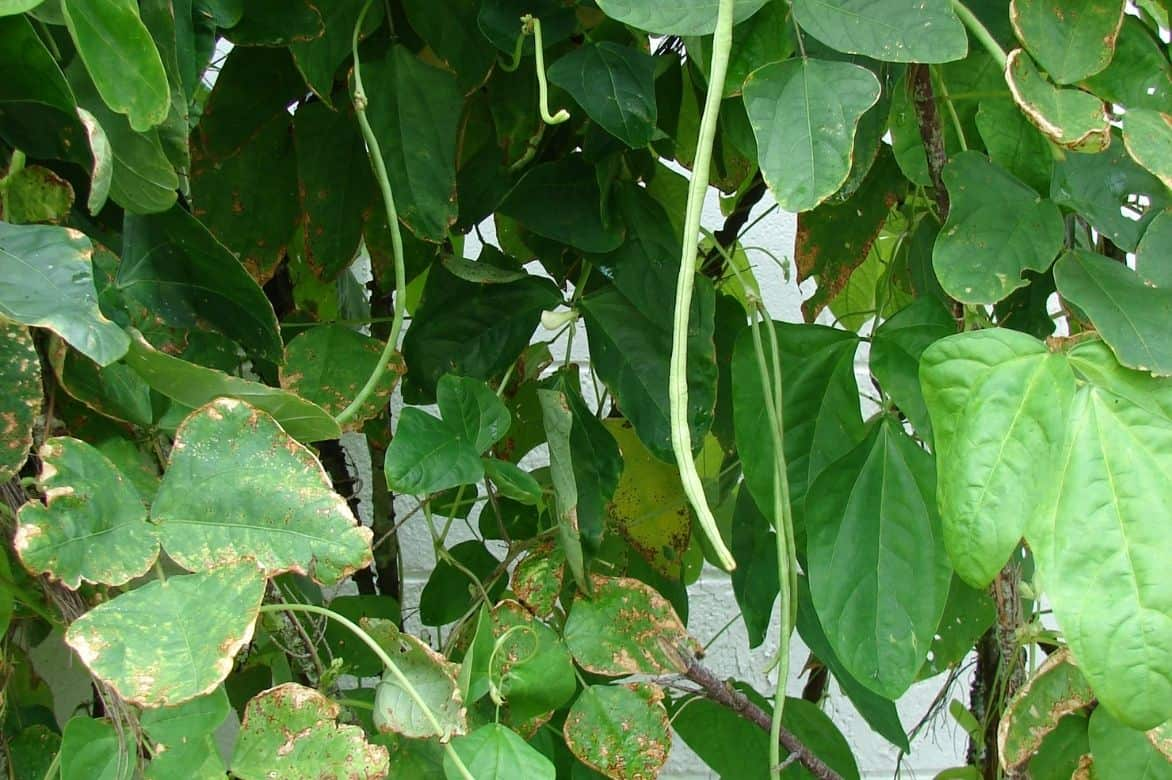
Ideally, kilometre bean pods should be harvested every 2 to 3 days when they have reached 30 to 40 cm.
Kilometre beans have a short shelf life. They can be kept for 2 to 3 days in the vegetable drawer of the refrigerator, wrapped in a damp cloth. Beyond this, the pods will soften.
How to cook these funny beans?
These surprising beans have a flavour that lies somewhere between green bean and asparagus. They can be consumed boiled in water or steamed, or sautéed in a wok or frying pan for about ten minutes with garlic, chives, and spices. Just remember to cut them into small pieces before cooking. Afterwards, they can accompany meat or fish in sauce.
If your kilometre beans have been harvested a bit mature, you can fry them. Kilometre beans can also be eaten raw in salads.
For further reading
- Are you a fan of unusual vegetables? Discover 10 more unusual vegetables to grow in your vegetable garden
- If you’re lacking inspiration for supporting your climbing beans, check out Ingrid’s two articles: supporting climbing varieties of vegetables and the bean teepee, an easy gardening activity with children
- The climbing bean has its place in a Mediterranean garden. I also explain which other vegetables to grow in a vegetable garden located in the South of France
- Subscribe!
- Contents































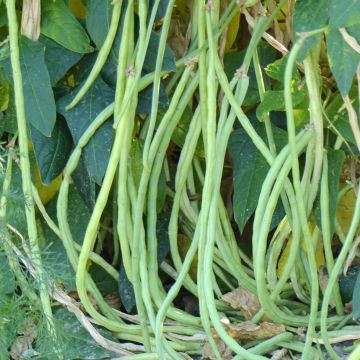


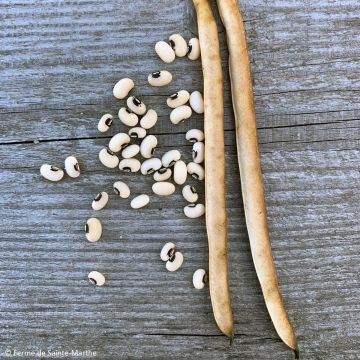
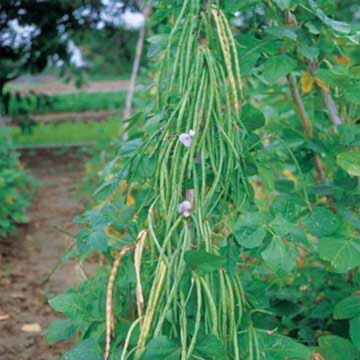
Comments